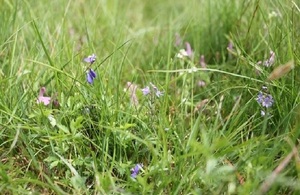Rampisham Down: a wonderful outcome for conservation
Work to save a rare example of ancient acid grassland is hailed today as a “wonderful outcome for conservation” by Natural England.

Wild flowers on Rampisham Down, Dorset © Sean Cooch, Natural England
Rampisham Down in Dorset is a surviving fragment of a once extensive area of marginal common land associated with medieval grazing.
In 2013 there were plans to create a solar farm on the site, which would have caused significant damage to the mosaic of nationally-important acid grassland and heath plant communities.
Natural England notified the grassland as a site of special scientific interest (SSSI) in 2014, giving it vital legal protection through the planning process, and lodged an objection to the proposed development of the site.
Local staff have since worked closely with British Solar Renewables (BSR), West Dorset District Council and other partners, such as the Dorset Area of Outstanding Natural Beauty Team and the Dorset Wildlife Trust, to find a solution. This resulted in BSR submitting alternative plans to create a solar farm on less sensitive land nearby, approved last month by West Dorset District Council.
Natural England’s Chairman, Andrew Sells, said:
This great success demonstrates the power of our outcomes approach, where we work in partnership with local people and businesses to solve problems and achieve significant benefits for the natural environment.
Natural England intervened in the case to save this site from development and has recently worked productively with all partners to find an alternative site. This is a wonderful outcome for conservation, in particular for Rampisham Down and the wildlife it supports.
The grasslands on Rampisham Down are a rare example of the marginal common land associated with medieval grazing systems. Its modern day survival was helped by its use as a BBC transmitter site for 70 years. It is the largest expanse of unimproved lowland acid grassland in Dorset and one of the largest in the country.
The mosaic of plants includes birds-foot trefoil, heath bedstraw, mouse-ear hawkweed, slender St John’s wort, tormentil and dwarf thistle. This rare habitat is home to declining farmland birds such as skylarks and is considered important for its fungi and insect communities.
The new solar farm proposals will result in the long-term management of a scheduled ancient monument, the medieval park pale earthwork, and the enhancement of wildlife associated with the alternative site, as well as the restoration and management of the special interests of the Rampisham Down SSSI.
Fran Davies, Natural England’s Area Manager, added:
The recent planning permission will deliver major energy benefits while taking full account of the environmental sensitivities of this incredibly important site for nature.
We welcome the long-term environmental management plans of the developer and would like to thank the Dorset AONB Team, Historic England, Dorset Wildlife Trust, Dorset Environment Records Centre and West Dorset Planners for working with us in the ongoing protection of this special site.